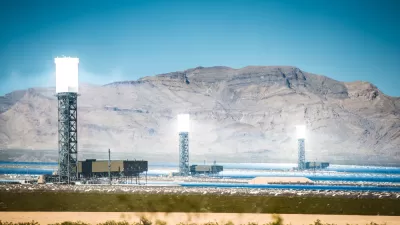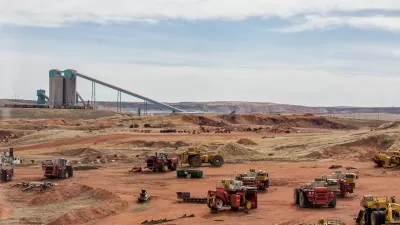It took less than a year for the EPA to finalize the Affordable Clean Energy rule, which will allow older coal-burning plants to continue operating, in the Trump administration's most consequential environmental rollback accomplished to date.

"The Trump administration on Wednesday replaced former President Barack Obama’s effort to reduce planet-warming pollution from [existing] coal plants with a new rule that would keep plants open longer and undercut progress on reducing carbon emissions," reports Lisa Friedman for The New York Times.
The measure represents the Trump administration’s most ambitious effort to protect coal and, along with its rollback of vehicle pollution rules and its plan to withdraw from the Paris climate agreement, ranks among its boldest moves to minimize the threat of global warming.
Both the Safer Affordable Fuel-Efficient (SAFE) Vehicles Rule that freezes fuel economy standards at the year 2020 levels and the withdrawal from the Paris accord, while announced and initiated, have yet to be finalized.
"The Trump rule largely gives states the authority to decide how far, if at all, to scale back emissions, while the Obama plan would have set national emissions limits and mandated the reconstruction of power grids to move utilities away from coal," continues Friedman. The Clean Power Plan never took effect having been suspended by the U.S. Supreme Court in February 2016 after a bipartisan coalition of 24 states sued the Environmental Protection Agency in October 2015.
By Wednesday afternoon, the new regulation, known as the Affordable Clean Energy [ACE] rule, had already prompted a flurry of challenges, with attorneys general in California, Oregon, Washington State, Iowa, Colorado and New York saying they intended to sue to block the measure.
At issue is whether the Environmental Protection Agency has authority to set national restrictions on carbon emissions and force states to move away from coal, as assumed under Mr. Obama’s rule. Under the Trump administration’s interpretation, the agency only has authority over environmental infractions at individual plants, like chemical spills and improper handling of hazardous materials.
Far-reaching political consequences of court battle
"The new rule could face an uphill battle in court," reports Anna M. Phillips for the Los Angeles Times. "The Clean Air Act obligates the federal government to regulate greenhouse gas emissions, and the Trump administration may have difficulty convincing the courts that its rule is the best way to do that."
"If the U.S. Supreme Court ultimately upholds the administration’s approach to pollution regulation, it would shut down a key avenue that future presidents could use to address climate change," notes Friedman.
“Unlike the Clean Power Plan, ACE adheres to the Clean Air Act and gives states the regulatory certainty they need to continue to reduce emissions and provide a dependable, diverse supply of electricity that all Americans can afford," said EPA Administrator Andrew Wheeler.
The rule is clearly a boon for the coal industry in the sense that federal regulation is greatly relaxed, if not essentially removed, but it still must deal with market forces, i.e., competition from natural gas and renewable energy sources such as wind and solar, which have resulted in the shuttering of more coal plants than under the Obama administration, and political efforts from environmental and public health opponents such as the recently announced Beyond Carbon campaign, launched by a $500 million donation from Bloomberg Philanthropies.
The ACE rule, which was submitted on June 19 to the Federal Register, becomes effective 60 days after it is published in the register.
Multi-media coverage
- NPR: Jeff Brady reports on All Things Considered on Wednesday afternoon.
- PBS Newscast: Juliet Eilperin, who reported with Brady Dennis on the rule finalization for The Washington Post, was interviewed on the PBS NewsHour by Amna Nawaz on Wednesday evening.
Related in Planetizen:
-
'Affordable Clean Energy Rule' Proposed to Replace Clean Power Plan, August 22, 2018
-
Coal Power Plants to Retire Faster Under Trump, May 15, 2018
-
Trump Administration to Repeal Obama's Clean Power Plan, October 9, 2017
-
Trump Targets Obama's Signature Environmental Rule, the Clean Power Plan, February 23, 2017
-
Supreme Court Puts Obama's Key Climate Initiative on 'Hold', February 10, 2016
FULL STORY: E.P.A. Finalizes Its Plan to Replace Obama-Era Climate Rules

Trump Administration Could Effectively End Housing Voucher Program
Federal officials are eyeing major cuts to the Section 8 program that helps millions of low-income households pay rent.

Planetizen Federal Action Tracker
A weekly monitor of how Trump’s orders and actions are impacting planners and planning in America.

Ken Jennings Launches Transit Web Series
The Jeopardy champ wants you to ride public transit.

Washington Legislature Passes Rent Increase Cap
A bill that caps rent increases at 7 percent plus inflation is headed to the governor’s desk.

From Planning to Action: How LA County Is Rethinking Climate Resilience
Chief Sustainability Officer Rita Kampalath outlines the County’s shift from planning to implementation in its climate resilience efforts, emphasizing cross-departmental coordination, updated recovery strategies, and the need for flexible funding.

New Mexico Aging Department Commits to Helping Seniors Age ‘In Place’ and ‘Autonomously’ in New Draft Plan
As New Mexico’s population of seniors continues to grow, the state’s aging department is proposing expanded initiatives to help seniors maintain their autonomy while also supporting family caregivers.
Urban Design for Planners 1: Software Tools
This six-course series explores essential urban design concepts using open source software and equips planners with the tools they need to participate fully in the urban design process.
Planning for Universal Design
Learn the tools for implementing Universal Design in planning regulations.
Heyer Gruel & Associates PA
Ada County Highway District
Institute for Housing and Urban Development Studies (IHS)
City of Grandview
Harvard GSD Executive Education
Toledo-Lucas County Plan Commissions
Salt Lake City
NYU Wagner Graduate School of Public Service




























